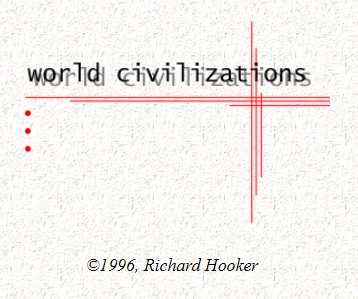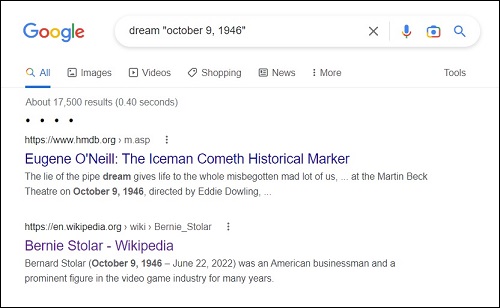"… just one aspect of a historical process
that we can legitimately call 'progress' –
not a romantic or utopian or naive ideal,
but an empirical fact that we can see
in graphs and numbers."
… and sometimes elsewhere . . .
"… just one aspect of a historical process
that we can legitimately call 'progress' –
not a romantic or utopian or naive ideal,
but an empirical fact that we can see
in graphs and numbers."
… and sometimes elsewhere . . .
"Might be a nice 20 page essay, but a bomb of a book"
— Herbert Gintis on Taleb's Black Swan , review dated April 10, 2012.
This remark might also be applied to Crumey's Mobius Dick :
Related material for Jungians who enjoy synchronicity —
The Log24 posts from the date of the Gintis review — April 10, 2012.

Tuesday, November 8, 2016, was also the publication date
at Princeton University Press for a book by one Herbert Gintis:
Gintis reportedly died yesterday, Jan. 5, 2023.
"He graduated from the University of Pennsylvania
and then attended Harvard University for post-graduate
work in mathematics. After receiving his master's degree,
he grew disillusioned with the field, and while at Harvard,
became a sandal maker with a shop in Harvard Square."
In later years, Gintis was associated with the Santa Fe Institute.

Pullman links in this journal —
http://m759.net/wordpress/?s=wsu.edu .
Specifically . . .
<a href="http://www.wsu.edu:8080/%7Edee/GLOSSARY/SHUCHUNG.HTM"
target="_new" rel="noopener noreferrer">
<strong><em>Shu</em>: Reciprocity</strong></a>
and
<a href="http://www.wsu.edu/%7Edee/GREECE/HERAC.HTM"
target="_new"><font size="6"><b>Logos</b></font></a>
Those links no longer work. See instead . . .
https://web.archive.org/web/20011224032243/
http://www.wsu.edu:8080/~dee/GLOSSARY/SHUCHUNG.HTM
and
https://web.archive.org/web/20011129072406/
http://www.wsu.edu/~dee/GREECE/HERAC.HTM .
Logo from these links:

Wallace Stevens —
"Reality is the beginning not the end,
Naked Alpha, not the hierophant Omega,
Of dense investiture, with luminous vassals."
— “An Ordinary Evening in New Haven” VI

This post was suggested by a "matrix rotator" photo dated 1953-03-02.
Some context — Kracauer's notion of "mass ornament."
Detail of the above screen (click to enlarge) —
See also this journal on the above date — June 10, 2021.
From this journal on May 6, 2009 —
A related picture of images that "reappear metamorphosed
in the coordinate system of the high region" —
(For the backstory, see Geometry of the I Ching
and the history of Chinese philosophy.)
The title is from . . .
https://booksonthewall.com/blog/samuel-beckett-quote-fail-better/ .
This post was suggested by yesterday's Feast of St. Thomas Becket —

A Beckett-related flashback linked to here yesterday —
"To get inside the systems of this work,
whether LeWitt's or Judd's or Morris's,
is precisely to enter
a world without a center,
a world of substitutions and transpositions
nowhere legitimated by the revelations
of a transcendental subject. This is the strength
of this work, its seriousness, and its claim to modernity."
"How a close group of brilliant friends,
in a tiny German university town, laid
the foundations of modern consciousness"
— Headline for the article whose URL is . . .
https://aeon.co/essays/
english-romanticism-was-born-from-a-serious-germanomania
The article was published by Aeon on December 20, 2022,
and is featured in today's Arts & Letters Daily . On the author:
"Andrea Wulf is a historian and the award-winning author
of several books, including the bestselling
The Invention of Nature (2015) and, most recently,
Magnificent Rebels: The First Romantics and
the Invention of the Self (2022). She is a Miller Scholar
and a Fellow of the Royal Society of Literature."

Related material — "The Eight" According to Coleridge.
"The novelist Cormac McCarthy has been a fixture around
the Santa Fe Institute since its embryonic stages in the
early 1980s. Cormac received a MacArthur Award in 1981
and met one of the members of the board of the MacArthur
Foundation, Murray Gell-Mann, who had won the Nobel Prize
in physics in 1969. Cormac and Murray discovered that they
shared a keen interest in just about everything under the sun
and became fast friends. When Murray helped to found the
Santa Fe Institute in 1984, he brought Cormac along, knowing
that everyone would benefit from this cross-disciplinary
collaboration." — https://www.santafe.edu/news-center/news/
cormac-and-sfi-abiding-friendship
Joy Williams, review of two recent Cormac McCarthy novels —
"McCarthy has pocketed his own liturgical, ecstatic style
as one would a coin, a ring, a key, in the service of a more
demanding and heartless inquiry through mathematics and
physics into the immateriality, the indeterminacy, of reality."
A Demanding and Heartless Coin, Ring, and Key:
COIN

RING
"We can define sums and products so that the G-images of D generate
an ideal (1024 patterns characterized by all horizontal or vertical "cuts"
being uninterrupted) of a ring of 4096 symmetric patterns. There is an
infinite family of such 'diamond' rings, isomorphic to rings of matrices
over GF(4)."
KEY
"It must be remarked that these 8 heptads are the key to an elegant proof…."
— Philippe Cara, "RWPRI Geometries for the Alternating Group A8," in
Finite Geometries: Proceedings of the Fourth Isle of Thorns Conference
(July 16-21, 2000), Kluwer Academic Publishers, 2001, ed. Aart Blokhuis,
James W. P. Hirschfeld, Dieter Jungnickel, and Joseph A. Thas, pp. 61-97.
For those who prefer a "liturgical, ecstatic style" —

"If the window is this matrix of ambi- or multivalence,
and the bars of the windows-the grid-are what help us
to see, to focus on, this matrix, they are themselves
the symbol of the symbolist work of art. They function as
the multilevel representation through which the work of art
can allude, and even reconstitute, the forms of Being."
— Page 59, Rosalind Krauss, "Grids," MIT Press,
October , Vol. 9 (Summer, 1979), pp. 50-64
Related material —
Click the above image for a related Log24 post of 15 years ago today.
A related literary remark —
"Imagine Raiders of the Lost Ark set in 20th-century London, and then
imagine it written by a man steeped not in Hollywood movies but in Dante
and the things of the spirit, and you might begin to get a picture…."
— Doug Thorpe in an Amazon.com book review, not of Dark Materials.
Published on Sept. 15, 2022. See as well this journal on that date.
Grids
Author: Rosalind Krauss
Source: October , Vol. 9 (Summer, 1979), pp. 50-64
Published by: The MIT Press
Stable URL: http://www.jstor.org/stable/778321
From page 59:
"Flowing and freezing; glace in French means glass, mirror, and ice;
transparency, opacity, and water. In the associative system
of symbolist thought this liquidity points in two directions.
First, towards the flow of birth-the amniotic fluid, the 'source'-
but then, towards the freezing into stasis or death-
the unfecund immobility of the mirror. For Mallarmé, particularly,
the window functioned as this complex, polysemic sign by which
he could also project the 'crystallization of reality into art.' 5
Mallarmé's Les Fenêtres dates from 1863;
Redon's most evocative window, Le Jour , appeared in 1891
in the volume Songes . If the window is this matrix of
ambi- or multivalence, and the bars of the windows-the grid-
are what help us to see, to focus on, this matrix, they are
themselves the symbol of the symbolist work of art.
They function as the multilevel representation through which
the work of art can allude, and even reconstitute, the forms of Being."
5 Robert G. Cohn, "Mallarmé's Windows," Yale French Studies ,
no. 54 (1977), 23-31.
Another evocative example — See Galois Window in this journal.
"The book I came back to
George Eliot’s Middlemarch. I couldn’t cope with it
as a student; it wasn’t until I was grown up, and married,
and a parent, and trying to teach it myself, that I realised
its majestic scope and depth." — Philip Pullman in
The Guardian, Fri 23 Dec 2022 05.00 EST
Another instance of scope and depth —
"The Amber Spyglass" Log24 post of Wednesday.
See also other references here to Middlemarch.

"Was ist Raum, wie können wir ihn
erfassen und gestalten?"
The Theory and
Organization of the
Bauhaus (1923)
A relevant illustration:
At math.stackexchange.com on March 1-12, 2013:
“Is there a geometric realization of the Quaternion group?” —
The above illustration, though neatly drawn, appeared under the
cloak of anonymity. No source was given for the illustrated group actions.
Possibly they stem from my Log24 posts or notes such as the Jan. 4, 2012,
note on quaternion actions at finitegeometry.org/sc (hence ultimately
from my note “GL(2,3) actions on a cube” of April 5, 1985).
These references will not appeal to those who enjoy modernism as a religion.
(For such a view, see Rosalind Krauss on grids and another writer's remarks
on the religion's 100th anniversary this year.)
Some related nihilist philosophy from Cormac McCarthy —
"Forms turning in a nameless void."
The 'harvard gsd' in the link button below is the Graduate School of Design.

Related material — "News of the World" in this journal.
"Most important for Canetti are certain events
that he calls 'illuminations,' such as his witnessing
of striking workers being mowed down by Viennese
police on July 15, 1927, which was the germ of both
Auto-da-Fé and Crowds and Power. For Canetti,
these epiphanies are moments of metamorphosis,
which he prizes above all in art as well as in life.
Canetti aspired to be a 20th-century Ovid, but
precisely because he was modern, this ambition
landed him, again and again, in paradox, such as
the one expressed in the aphorism that gives this
compilation its title, or in this characteristic maxim:
'It all depends on this: with whom we confuse ourselves .'"
— Hal Foster in The Chronicle of Higher Education ,
"The Best Scholarly Books of 2022," Dec. 21, 2022.
See also this journal on Nov, 25, 2022 —
Last year on this date:
A Riddler Wannabe —
Related material — The Krauss passage quoted as above
by Shechtman in The New Yorker in December 2021 appears
also in a Log24 post of October 18, 2017: "Three Small Grids."
Today's previous post "The Urn" suggests a look at . . .
How to Solve The New York Times Crossword
By Deb Amlen. Illustrations by Elena Xausa.
Animations by Lorenzo Fonda.
That web page is undated, but its HTML source contains
43 instances of the date 2017-10-18.
See as well "Three Small Grids," a post from this journal on 2017-10-18.
Related material — Today's 3:05 PM ET New York Times obituary
for the above crossword guide illustrator, Elena Xausa —
https://www.newyorker.com/magazine/2022/12/26/the-cover-crossword
"The two cover characters, who I’ve been thinking of as ○ and □ . . ."
— Chris Ware on his New Yorker cover for the issue dated Dec. 26, 2022.
(See earlier posts referring to that theory.)

Catching up to Pullman's Oct. 3 remark . . .
See Log24 posts now tagged October 1-2-3.

Midrash from Philip Pullman . . .
"The 1929 Einstein-Carmichael Expedition"
I prefer the 1929 Emch-Carmichael expedition —
This is from . . .
“By far the most important structure in design theory
is the Steiner system S(5, 8, 24).”
— “Block Designs,” by Andries E. Brouwer
(Ch. 14 (pp. 693-746) of Handbook of Combinatorics,
Vol. I, MIT Press, 1995, edited by Ronald L. Graham,
Martin Grötschel, and László Lovász, Section 16 (p. 716))
Circle and Square at the Court of King Minos —

Harmonic analysis based on the circle involves the
circular functions. Dyadic harmonic analysis involves …
For some related history, see (for instance) . . .
|
When?
Going to dark bed there was a square round Where?
— Ulysses , conclusion of Chapter 17. |
For seekers of a "crazy Christmas knot" —
The commercial logo below may be viewed as
three in-folded Y-shaped orange forked tongues.

See also a Log24 post from Dec. 5, the lawyer's dies natalis.
The above title phrase is from the Windows lockscreen
I encountered at 7:59 AM ET today:

Some related mathematical windmills —
|
For the eight-limbed star at the top of the quaternion array She drew from her handbag a pale grey gleaming implement that looked by quick turns to me like a knife, a gun, a slim sceptre, and a delicate branding iron—especially when its tip sprouted an eight-limbed star of silver wire. “The test?” I faltered, staring at the thing. “Yes, to determine whether you can live in the fourth dimension or only die in it.” — Fritz Leiber, short story, 1959 |
See as well . . .
From Peter Woit's weblog today —
The New Yorker and the Publicity Stunt
Posted on December 12, 2022 by woit
The wormhole publicity stunt story just keeps going.
Today an article about the Google Santa Barbara lab
and quantum computer used in the publicity stunt
appeared in the New Yorker.
From The New Yorker itself —
See also a very different take from another New Yorker author —
(Cf. Log24, Plan 9 at Yale, Nov. 13, 2017).
The "Cottage Industry" of the title is the "Modernism" racket
of today's 1 AM post — a subsidiary of Academia that
uses some of the same marketing techniques as Hollywood . . .

See also "Plato's Ghost" in this journal.
The above tag "Academy Century" is a nod to an earlier tag,
"Academy Year," that refers to Dec. 7, 2021-Dec. 7, 2022 . . .
the dates of a Deerfield Academy publication and of a Log24 post.
Some remarks from a more advanced academy —
"This year marks the centenary of modernism's annus mirabilis ."
— Johanna Winant in Boston Review, December 7th, 2022.
Some will prefer a different annus mirabilis .
A music producer pawns his current drum device
and acquires a demonic 1970s machine.
Related material —
This post was suggested by a remark made during the filming
of "Edge of Tomorrow," by a Log24 post on the new Nolan film
about Oppenheimer, and by the work of a different Edge:
"… a reality that only my notes can provide."
— Kinbote in Nabokov's novel Pale Fire
* The word "artification" is from yesterday's Letter of the Law.
The above date of a letter from Kurt Gödel — 7 January 1954 —
appears also in an instance of the word "artified" that seems* to be
outside the usual realms of English usage —

* Related "artified" references — Try a Google Books search and . . .
Morf Vandewalt might enjoy the bibliography from Dreon's article.
From this journal on Dec. 2 —
"Please wait as your operating system is initiated."
Update of 2:30 PM ET:
"You can't make this stuff up."

A related problem:
"What powers the Velvet Buzzsaw?"
Perhaps the Santa Fe Institute . . .
Logo of the Santa Fe Institute —

Perhaps Morf Vandewalt …
… Perhaps, as the above Hockney date suggests,
Louis Menand —
|
Alicia — "Gödel never says outright that there is a covenant to which all of mathematics subscribes but you get a clear sense that the hope is there. I know the allure. Some shimmering palimpsest of eternal abidement. But to claim that numbers somehow exist in the Universe with no intelligence to enable them does not require a different sort of mathematics. It requires a different sort of universe." Psychiatrist — "Is there such a universe?"
— McCarthy, Cormac. Stella Maris (p. 180). |
A palimpsest from Oslo artist Josefine Lyche —

Centrality in Time —
About halfway through the Netflix version:

Centrality in Space —
About halfway through a print version:

* See El Pato in the March 2004 post Deep Play.
The Strogatz tweet linking to Gödel's 1951 Gibbs Lecture
in yesterday's Log24 "On the Road" post omitted the name
of the author of the introductory note in the linked-to document.
It was George Boolos:
Josefine Lyche, sketch for a sculpture: "Truth, Knowledge, Belief."
The sketch itself appears to be in a transparent plastic envelope,
and the triangle figure from Finnegans Wake is apparently from
the envelope, not from the sketch proper.
See also Epistemology in Norway.
Banana Beach:

Banana Beach is on the island of Príncipe. Wikipedia —
"Príncipe was the site where Einstein's theory of relativity
was experimentally corroborated by Arthur Stanley Eddington
and his team during the total solar eclipse of May 29, 1919."
Related cultural notes —
"… as today we look back on Eddington's
1919 eclipse observations…." —

"Does the phrase 'vinegar and brown paper'
mean anything to you?"
"Well. You can spend a lot of time categorizing realities.
Their correspondences. We probably dont want to start
down that road."
— McCarthy, Cormac. Stella Maris (p. 64).
Knopf Doubleday Publishing Group. Kindle Edition.
But if you do want to . . .

… Suggested by, among other things, a Saturday evening post.


See as well the concluding paragraphs of . . .
https://www.nytimes.com/2022/12/03/books/john-prados-dead.html .
"… in the marketplace of ideas, a good story
often outsells mere facts."
— Library of Congress webpage arguing against the popular
legend that "Ring Around the Rosie" is about the Black Plague
* The second tab above is from today's obituary of a woman whose
flower shop, “Ring Around a Rosy,” adjoined the Library Theatre
in Warren, Pennsylvania.
2 and 3.
(See The Rimshot Muse
and Interality Again.)
This post was suggested in part by
a thoughtful obituary yesterday for
the author of The Number Devil .
I prefer Numberland .
Eric Rosenblum in The New Yorker yesterday:
"Her English teacher introduced Dunn to Thoreau’s 'Walden,'
from which she later said that she learned 'the concept that
if you examine anything closely you will see all of the forces
of the universe at work.' As a student at Reed College, Dunn
found a kindred spirit in her poetry professor, Galway Kinnell,
the first writer who could serve as a plausible role model—
like Dunn, Kinnell had escaped working-class roots to study at
an élite college."
See also other Log24 posts tagged Kinnell .
See also Turyn in this journal.
A Log24 post from the above date —
October 24, 2022 — suggests
a related cinematic image:
"Please wait as your operating system is initiated."
The above remarks from 2010 were suggested by
a weblog post by Peter Woit yesterday and by tonight's
Season 2 Teaser of "The Peripheral."


From Log24 last summer . . .
From Log24 yesterday:
Catchup for Blockheads . . . Da Capo
Related material: Posts tagged Metadata.
From https://dash.harvard.edu/ a straightforward search now leads to . . .

Clicking on the above "Square Model" link leads to a summary page
with a "citable link" to itself . . .
https://nrs.harvard.edu/URN-3:HUL.INSTREPOS:37373777 :

— and then, clicking on the summary page's
"View/Open The square model of PG(3,2). (329.1Kb),"
you will see a two-page PDF . . .

— and finally, scrolling down on that PDF, you will come to . . .
 .
.
Or you can just Google Cullinane square model .
"All manner of thing shall be well
When the tongues of flame are in-folded
Into the crowned knot of fire
And the fire and the rose are one."
— T.S. Eliot, “Little Gidding” (1942)
For seekers of a "crazy Christmas knot" —
The commercial logo below may be viewed as
three in-folded Y-shaped orange forked tongues.

See also this journal on the above opening date — July 23, 2021:
Cover illustration:
Spies returning from the land of
Canaan with a cluster of grapes.
Colored woodcut from
Biblia Sacra Germanica ,
Nuremberg, Anton Koberger, 1483.
Victoria and Albert Museum, London.
"What happens in Canaan, stays in Canaan."
The date — January 9, 2010 — of the Guardian book review
in the previous post was noted here by a top 40 music list
from that same date in an earlier year.
Update of 4:07 AM ET the same morning:
Fans of Cormac McCarthy's recent adventures in unreality
might enjoy interpreting the time — 3:25 AM ET — of this post
as the date 3/25, and comparing the logos, both revisited
and new, in a Log24 post from 3/25 . . .
Helen Mirren with plastic Gankyil .
. . . with the logo of a venue whose motto is
"Reality is not enough."
The title is a phrase from a 2010 Guardian book review.
The book under review was by one Hans Magnus Enzensberger,
who reportedly died at 93 on Nov. 24 in Munich.
Also on Nov. 24 —
"Rubik's Cube, and the simpler [2x2x2] Super Cube, represent
one form of mathematical and physical reality."
— Solomon W. Golomb, "Rubik's Cube and Quarks:
Twists on the eight corner cells of Rubik's Cube
provide a model for many aspects of quark behavior,"
American Scientist , Vol. 70, No. 3 (May-June 1982), pp. 257-259
From the last (Nov. 14, 2022) of the Log24 posts now tagged Groups and Spaces —
From the first (June 21, 2010) of the Log24 posts now tagged Groups and Spaces —
See as well . . .
"But let us return to the concepts of the divide [écart ]
and interspace [l'entre ], which figure prominently in my work…."
The name "Hickey" in last night's post suggested the phrase
"pipe dream" and a search for the opening date of
"The Iceman Cometh" — which was October 9, 1946.

That date, it happens, was the birth date of a video game
executive whose passing was noted here . . .
"Both Hal and the students were great interlocutors
with lots of ideas and differing perspectives."
—Leah Dickerman, MoMA, May 10, 2010, at
https://www.princeton.edu/news/2010/05/10/
class-snapshot-origins-abstraction
Later . . .
See as well Desargues + Galois.
"A struggling music producer sells his soul to a 1970s drum machine."
— Summary of a short film by Kevin Ignatius, "Hook Man."
The music producer pawns his current drum device
and acquires a demonic 1970s machine.
Artistic symbolism —
The 16-pad device at left may be viewed by enthusiasts of ekphrasis
as a Galois tesseract, and the machine at right as the voice of
Hal Foster, an art theorist who graduated from Princeton in 1977.
For an example of Foster's prose style, see
the current London Review of Books.


* "The Long Dark Trail" is the title of a recent film
directed by a later resident of 505 Market Street.
In memory of an economist who reportedly died on Nov. 6 —
See also a Log24 post from Prescott's reported death date,
and a search in this journal for Prescott Street.

A literary note for Ho, from this journal on October 27, 2008 —

A day earlier — October 26, 2008 — was the date of a very
informative, but deeply tasteless, introduction to . . .

That introduction need not be quoted here.
" The term jaeger is German for 'hunter.' "
— Thomas Tull, producer, at 0:42 / 4:10 in
Pacific Rim – "Jaegers: Mech Warriors" Featurette
Related language notes —
"Drift" in Pacific Rim and "Haptic Drift" in The Peripheral .
See also …
"The story begins with the the doctor asking Trexler
if he has any bizarre thoughts."
— Description of a classic E. B. White story,
"The Second Tree from the Corner."
… and a particular second tree from a particular corner:
From a Charlbi Dean film —
See as well Season 1 of the HBO series "White Lotus" —
"Apart from its great antiquity the picture-story mode of presentation
favored by the unconscious has the appeal of its simple utility.
A picture can be recalled in its entirety whereas an essay cannot."
— Cormac McCarthy, essay on language and the unconscious,
April 17, 2017, quoted in a post of November 9, 2022.


See also Soifer in this journal and . . .

Related philosophical remarks —
Related entertainment —
"Nietzsche in Basel studied the deep pool
Of these discolorations, mastering
The moving and the moving of their forms
In the much-mottled motion of blank time."
— Wallace Stevens, "Description Without Place"
Also in Basel, a mathematics professor contemplated the Lo Shu —
Powered by WordPress